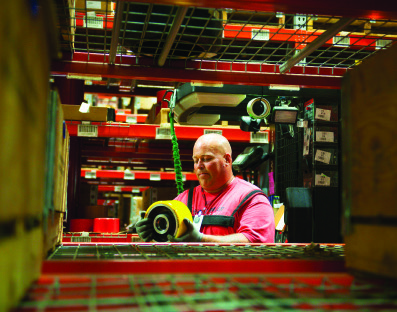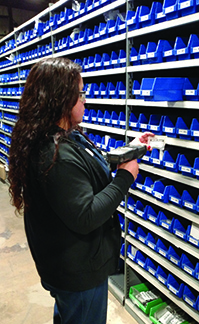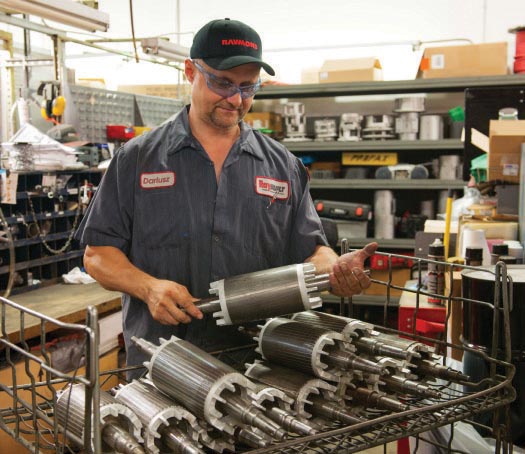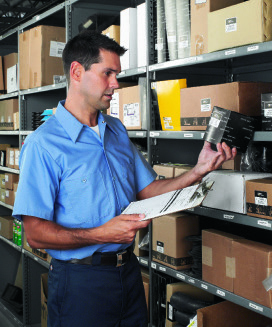Optimize Spare Parts Management (and realize its potential)
As demand for more efficient spare parts management continues to increase, lift truck fleet managers are streamlining their parts inventory, storage and usage

The concept of integration is familiar to many solution providers and their customers. However, it’s just beginning to creep into the perspective of fleet managers, who increasingly need to look at a system-wide view of their equipment, maintenance practices and spare parts management.
Technology systems and training options can better optimize the inventory, storage and usage of forklift parts, but a successful program requires a holistic view. Successful partnerships between end-users, dealers and original equipment manufacturers (OEMs) also require networks dedicated to flexibility and per-customer service, including same-parts availability and other parts delivery options.
To better manage spare parts and ensure more successful partnerships, experts say fleet managers must identify mission-critical parts, have a strong network to get parts in an emergency as well as have a solid inventory management system to track what’s available for use.
Identify mission-critical parts
 Fleet managers often have difficulty identifying mission-critical parts. In fact, according to Michael Toering, parts marketing manager for Mitsubishi Caterpillar Forklift America (MCFA), the identification is a “balancing act” without any formula. However, fleet managers can implement three best practices as they identify parts. First, they can stock items—usually higher mortality or wear objects that are replaced at planned intervals like 500 hours—from manufacturers’ lists of important replacement parts.
Fleet managers often have difficulty identifying mission-critical parts. In fact, according to Michael Toering, parts marketing manager for Mitsubishi Caterpillar Forklift America (MCFA), the identification is a “balancing act” without any formula. However, fleet managers can implement three best practices as they identify parts. First, they can stock items—usually higher mortality or wear objects that are replaced at planned intervals like 500 hours—from manufacturers’ lists of important replacement parts.
Second, fleet managers can refer to prior purchase reports or model-specific items that are often replaced. And finally, managers can also stock application-specific parts that have higher replacement rates based specifically on the operating environment.
“For example, cooling system parts will have a higher replacement rate in a foundry or other heat-intensive operation,” Toering says. “Often bearings, seals and gaskets will require frequent replacement in brine or fishery applications where salt water is a factor.”
Joe Fredericks, corporate parts manager for Raymond Handling Concepts, says the task of prioritizing parts can be difficult since ultimately all lift truck parts are necessary to uptime. However, he stresses that history—especially records that offer insights into the parts that have been replaced—and experience are the two most important indicators for mission-critical parts identification. When history is combined with experience, parts that need to be replaced—and their impact on productivity—can be identified more easily.
“Since we stock appropriate parts to ensure customer uptime, sometimes we override computer-recommended stocking levels and add a part to our inventory that otherwise wouldn’t be stocked,” Fredericks says. “We then use the experience of our parts staff and service department to make these exceptions and track them, using exception reports, to monitor their movement.”
The ability to identify mission-critical parts from history with like equipment or applications is very important, adds Kevin Sweet, vice president of operations for Atlas Toyota Material Handling. “Communication between customers, technicians and parts and service managers must occur though; with proper communication, such parts can be identified more easily.”

Put out fires during critical situations
Oftentimes, there’s no way around it: Parts, whether they are mission-critical or not, are needed fast, and the transfer and delivery of the parts is a challenge. To acquire parts quickly and avoid potential issues as much as possible, dealers and service providers should develop flexible capabilities like having parts transferred between locations, offering next-day shipping, or otherwise thinking creatively about how to optimize available inventory.
“With regard to back-ordered parts, we usually look to see if we have another truck we can temporarily take the part from until a new part arrives,” says ProLift Industrial Equipment’s corporate sales support manager Tory Beiting. “We may also look to see if the individual part might come in an assembly. If the assembly is available, we can order it to receive the part we need.”
To further “put out fires” during critical situations when parts are needed rapidly, MCFA’s Toering advises fleet managers to work toward same-day availability, rather than next-day ground service. With this in mind, Toering advises dealers to stock parts locally, according to their own unique, installed equipment base, as they will be able to deliver parts on the same day they’re purchased.
“However, if local dealers are out of stock, fleet managers will have to look for alternative ways to keep their fleet operating or else their productivity will decline,” Toering says.
As an alternative, managers may consider opportunities like guarantees—in which parts (including freight) are free for customers if they are not delivered to local dealers’ locations within 24 hours of orders being placed.
“There are some exceptions to these guarantees, but such programs are in place to help ensure fleet managers do not lose unnecessary downtime while they’re waiting for critical parts,” Toering adds.
Use inventory and parts management technology
 As a further means of minimizing downtime, fleet managers may also use an assortment of inventory management technologies, from storage bins and racks to software for on-site or remote technicians. The options are broad and usually depend on the ways in which managers have established their inventory systems. For example, oftentimes consignments are managed and restocked by dealers who install shelves, racks and bins that can store consignment parts. If fleet managers are overseeing their own parts, they can be inventoried with the corporate software the fleet uses.
As a further means of minimizing downtime, fleet managers may also use an assortment of inventory management technologies, from storage bins and racks to software for on-site or remote technicians. The options are broad and usually depend on the ways in which managers have established their inventory systems. For example, oftentimes consignments are managed and restocked by dealers who install shelves, racks and bins that can store consignment parts. If fleet managers are overseeing their own parts, they can be inventoried with the corporate software the fleet uses.
“For off-site or remote technicians, meanwhile, each van or remote facility typically has its own inventory already set up,” says Kevin Fick, director of aftermarket sales for UniCarriers Americas Corp. “Some companies also choose to set up each van or facility as a separate warehouse, while others assign each van or facility a separate location within a master warehouse.”
To ensure parts are optimally stocked for each customer, many dealers are also using enterprise resource planning (ERP) systems, along with Web-based fleet management and reporting tools, which result in transparent interactions between dealers, manufacturers and customers.
“Fleet maintenance software applications are getting put into use more frequently because they generate a dialogue between the fleet and the parts department,” Toering says. “When managers log into dashboards that display up-to-the-minute hour meter readings and fleet expense, down to the specific model and repair job, they provide ‘here and now’ snapshots of exactly which parts might be required now or in the very near future.”
In addition to using inventory management technologies, fleet managers are monitoring the location and usage of their parts. Systems with built-in, customizable reporting and paperless work order programs are used to submit orders electronically from the field for invoicing, saving time and increasing the accuracy.
“Paper work orders that used to take two weeks to close, on average, can now be completed electronically in just two days,” Fredericks says. “All equipment we work on is bar coded—with QR, PDF417 or MicroPDF417 bar code labels that technicians can scan and enter quantities for—with information required for work order headers.”
A technician can scan a label and the appropriate fields will be populated on the work order, resulting in a reduction of errors that occur when codes need to be keyed in manually, as well as improved work order accuracy.
Offer certified technical training
From time to time, spare parts are simply used too often, generally due to maintenance training issues. Sometimes in-house or outside service providers can’t troubleshoot accurately, so the customer will spend money to replace incorrect parts. Another issue that can be recognized during routine maintenance is abuse or other parts failure resulting from improper forklift operation.
Some companies offer factory-certified technical training so their customers can use accurate checking processes that help them replace appropriate parts and solve problems without spending time or money on parts they don’t need.
“Once operators are properly trained, fleet managers will experience savings on downtime, maintenance and parts cost,” Fredericks says.
It is also possible to identify parts orders that are abnormal, for example, one-time specific orders. These orders can be exempted from minimum or maximum on-hand adjustments. Parts and inventory managers will then oversee weekly stock order reports to identify which parts should be added to (or removed from) inventory before stock orders are placed.
“These parts are usually identified by business systems that determine either an increase or decrease in sales,” Sweet says. “Fleet managers will then look into the reason for these sales decreases or increases to quantify the parts that are being added to—or removed from—their inventory, resulting in a potential rise in their bottom lines.”
Companies mentioned in this article:
- Atlas Toyota Material Handling
- Mitsubishi Caterpillar Forklift America (MCFA)
- ProLift Industrial Equipment
- Raymond Handling Concepts
- UniCarriers Americas Corporation

Article Topics
MRO News & Resources
Avidbots showcases autonomous cleaning robots Traka exhibits modular lockers MRO Survey: Finding and keeping the best technicians Maintenance, Repair and Operations: Understanding the true condition of the equipment Newly formed Bison combines AMETEK DFS and Bison Gear and Engineering Corp. Building (and maintaining) your maintenance, repair and operations (MRO) tech workforce The power side of lift truck battery and charger maintenance More MROLatest in Materials Handling
ASME Foundation wins grant for technical workforce development The (Not So) Secret Weapons: How Key Cabinets and Asset Management Lockers Are Changing Supply Chain Operations MODEX C-Suite Interview with Harold Vanasse: The perfect blend of automation and sustainability Consultant and industry leader John M. Hill passes on at age 86 Registration open for Pack Expo International 2024 Walmart chooses Swisslog AS/RS and software for third milk processing facility NetLogistik partners with Vuzix subsidiary Moviynt to offer mobility solutions for warehouses More Materials HandlingAbout the Author
Subscribe to Materials Handling Magazine

Find out what the world's most innovative companies are doing to improve productivity in their plants and distribution centers.
Start your FREE subscription today.
April 2024 Modern Materials Handling

Latest Resources










